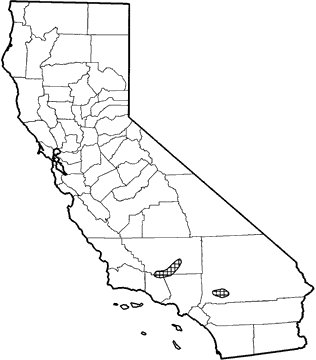
White-eared Pocket Mouse
Distribution, Abundance, and Seasonality
The white-eared pocket mouse historically has been found in isolated, montane areas inthe Tehachapi Mts., and in the San Bernardino Mts. in the vicinity of Strawberry Peak. Its elevational range is 1070-1800 m (3500-5900 ft). The white-eared pocket mouse is poorly known, but appears to be a scarce resident in ponderosa and Jeffrey pine habitats, and uncommon in mixed chaparral and sagebrush habitats. It recently has been captured in a fallow field dominated by Russian thistle. Apparently no specimens havebeen collected since 1938 in the San Bernardino Mts.; this population may no longer exist.

Range Map
Specific Habitat Requirements
Feeding: Feeds on plant seeds, probably preferring various grass seeds, and perhaps some insects. Forages on open ground and beneath shrubs.
Cover: Burrows are constructed in loose soil. The closely related Great Basin pocket mouse is more common in denser shrub habitats.
Reproduction: A nest of dried grass is built in a chamber of the underground burrow.
Water: No data found. Probably does not require free water.
Pattern: Grinnell (1933) stated that the species occupies dry, open pine forest where bracken fern grows. Current pattern is unclear.
Species Life History
Activity Patterns: Nocturnal. Aestivates in very hot weather, and hibernates in very coldweather.
Seasonal Movements / Migration: None. Home Range: No data found.
Home Range: No data found.
Territory: No data found. Reproduction of related P. parvus is March to April, with peak in June. Gestation likely 21-28 days. Litter size ranges 3-8 withaverage of 5. Weaning likely within 3 wk.
Reproduction: Likely predators include foxes, coyotes, weasels, owls, andsnakes.
Niche: The white-eared pocket mouse, like the yellow-eared pocket mouse, probably represents a relict distribution of P. parvus in California. P. parvus is endemic to sagebrush habitats; P. alticola and P. xanthonotus also inhabit chaparral-sagebrush habitats. Inferences about life history of P. alticola and P. xanthonotus from data on P. parvus probably are correct and are used extensively above. James Sulentich and David Huckaby of California State University, Long Beach investigated P. alticola, and captured only 3 specimens in extensive trapping in 1979 and 1980. The species may be in danger of extinction.
Sources & References
California Department of Fish and Game, 1999.
California's Wildlife, Sacramento, CA.
Written by: P. Brylski, reviewed by: H. Shellhammer, edited by: R. Duke
Grinnell, J. 1933. Review of the recent mammal fauna of California. Univ.Calif.Publ. Zool. 40:71-234.Ingles, L. G. 1965. Mammals of the Pacific states. Stanford Univ. Press,Stanford, CA. 506pp.Jameson, E. W., Jr. 1954. Insects in the diet of pocket mice, Perognathusparvus. J. Mammal. 35:592-593.Williams, D. F. 1978. Karyological affinities of the species groups ofsilky pocket mice (Rodentia, Heteromyidae). J. Mammal. 59:599-612.Williams, D. F. 1986. Mammalian species of special concern in California.Calif. Dept. Fish and Game, Sacramento. Admin. Rep. 86-1. 112pp.
California Animal Facts | California's Wildlife